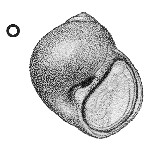
Revised descriptions of New Zealand Cenozoic Mollusca from Beu and Maxwell (1990)

 | Revised descriptions of New Zealand Cenozoic Mollusca from Beu and Maxwell (1990) | 
|
  (Pl. 47o): GS1163, R22/f6498, Kai-Iwi siltstone beds, west of Castlecliff, Wanganui, Castlecliffian (GNS, early collection) |
Beu & Maxwell (1990): Chapter 16; p. 352; pl. 47 o.
Synonymy: Natica zelandica Quoy & Gaimard 1832, p. 237, pl. 66, fig. 11, 12; Cochlis zelandica; Tanea zelandica
Type species of Tanea Marwick, 1931
Classification: Naticidae: Naticinae
Description: Moderate-sized for family (25-33 mm high), smooth and oval to subspherical, with low spire, well impressed sutures, and inflated spire whorls. Aperture large, D-shaped, with evenly rounded anterior. The only sculpture is of weak growth lines, weakly retracted to suture. Umbilicus about 0.6-0.8 filled by a large, rounded funicular ridge, ending in a smooth semicircular funicle, leaving a narrow but deep umbilical chink above funicle but only a narrow groove lower down, around ridge; inner lip otherwise weakly callused. Operculum (remaining inside the aperture of a small proportion of Castlecliff fossils, but otherwise rarely found fossil) semicircular, thin, smooth except for weak growth lines and 2 narrow, shallow grooves close to and parallel to outer-lip margin. Protoconch small, low-conical, of 2.5 low, narrow, smooth whorls.
Comparison: Tanea is a typical shell-boring naticid carnivore, drilling bevel-edged holes in a wide variety of bivalves and gastropods, but most commonly in small venerids such as Tawera. Evidence of their carnivory is seen in the drill holes in many fossils in the same beds as the Tanea shells (not to be confused with the cylindrical holes drilled by many Muricidae). Tanea zelandica is the Pliocene to Recent New Zealand representative of a widespread Pacific genus, closely related to Natica (sensu stricto), differing from Natica principally by its distinctive radula and by the two narrow opercular grooves (two much more prominent grooves occur on Natica opercula, many prominent ones on Naticarius, and most other naticine genera have almost smooth opercula). Modern specimens have a colour pattern of four rows of crescentic or chevron-shaped, dark brown spots on a pale fawn ground, and the spots remain on many Castlecliff fossils. The Miocene T. consortis (Pl. 20i) and other pre-Nukumaruan species have lower spires and wider shells than T. zelandica, whereas the Pliocene to earliest Castlecliffian Taniella planisuturalis (Pl. 41n) differs in its smaller size, its larger funicle, and its somewhat taller spire, with much more weakly impressed sutures and so almost straight spire outlines.
Distribution: Nukumaruan-Recent; Recent, New Zealand (type). Common throughout New Zealand on sand in shallow water (commonly cast ashore alive on ocean beaches), and a common fossil in all shallow-water, soft-bottom facies of Nukumaruan and Castlecliffian age.
Cite this publication as: "A.G. Beu and J.I. Raine (2009). Revised
descriptions of New Zealand Cenozoic Mollusca from Beu and Maxwell (1990). GNS
Science miscellaneous series no. 27."
© GNS Science, 2009
ISBN
978-0-478-19705-1
ISSN 1177-2441
(Included with a PDF facsimile file
copy of New Zealand Geological Survey Paleontological Bulletin 58 in CD version
from: Publications Officer, GNS Science, P.O. Box 30368 Lower Hutt, New
Zealand)